DonQuixote
DonQuixote (Originalregel)
Before the start of the game
With /join can enter 1-4 players into the game. With /start the game begins. Alternatively, you can use the game management use.
The game
DonQuixote is a laying game where every player has to try to make his way maps as optimal as possible to build a road network that connects as many elements as possible of the game (kirches, windmills, knights). But even the best card, if you have to play it at an unfavourable time, can ruin the elaborate plan. In this way, you have to throw constant plans over the pile during the game and improvise and optimize with the available.
Field
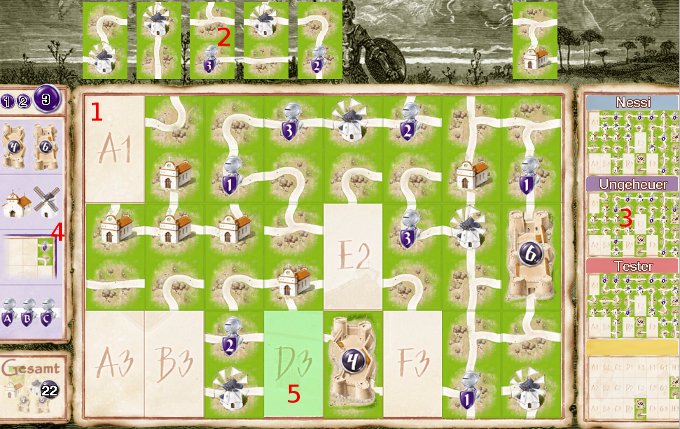
- Principality
- Road maps
- Player display: If you have a mouse over an opposing name, its principality will be displayed in full format. The colored submission of the names always disappears as soon as a player has already placed a card for the current passage.
- Value indicator/help (see below)
- Current Legefeld
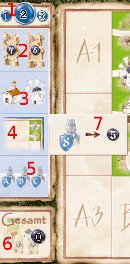
- Displaying the current round/value (the number of current rounds is shown large).
- Value indicator for the castles:
- Valuation display for churches and windmills
- Value indicator for the national defence
- Value indicator for the largest knight group (only value 3)
- Current total point
In principle, the current total point number is displayed for all elements. In order to selectively display a specific value, the mouse must be moved to the corresponding round pointer above.
If one passes with the mouse over the four score displays, the score conditions for the Current round (in the image on the left, for example, the national defense).
Game preparation
Each player has an identical set of 22 tickets and a principality with 24 places. The two castles are automatically randomly placed in the Principality. The position of the castles is the same for each player.
Game sequence
Each player must interpret his 22 way tickets in his own principality. This is done in three passages: In 1./2./3. Each player will complete 9/7/6 maps in his principality. The place for the cards is randomly selected and displayed by the green marking. This is identical for all players. After each round follows a score. After the third score the game ends.
Delaying maps
In the first round, each player has nine free way tickets. At first, a position card valid for all players will be revealed, which indicates the laying place for the first to be legendary road map (here in the BrettspielWelt the corresponding field in the Principality is marked green). If, for example, the first B3, all players must place one of their nine cards in their principality on B3. The following must be taken into account when depositing the cards:
- Any card that is still open may be placed. Exception: In the third round, the card can only be placed at the end as the last card! The maps can easily be dragged to the green marked field (and only there!).
- Each card can before laying rotated by 180 degrees. Other directions are not possible! To rotate, click the card in the upper or lower area once.
- A map once placed can no longer change its position!
- The maps do not necessarily have to be placed carcassonne (street road or meadow).
- Each castle has exactly two way connections. A castle basically separates the two paths following them.
Value
All three scores are in principle equal. Only in the third score there are additional points for the largest knight group (see below). "Connecting" always means "connected by roads" when valued. The points are distributed as follows:
Churches and Windmills
Points for Churches there is only when they are connected to other churches. So a single church without connection to at least one other church doesn't count. There are two points for exactly two connected churches. For larger groups, two points are obtained per church (e.g. eight points for four churches). For Windmills count the same laws as for churches. A connection of windmills and churches does not give any points!
Castles
Castles score points when connected to knights. Depending on the value Number the knight a role: at 1./2./3. At least 1/2/3 knights must be connected to a castle. The strength of the knights is irrelevant. If these conditions are fulfilled, four or six points are obtained depending on the castle. If knights are connected to both castles, they also count for both.
National defence
In order to contribute to the national defence, a knight must meet the following criteria:
(a) He must be placed on an edge of the Principality.
(b) It must be direct Connection from the knight to the outside
(c) The card half with the knight symbol must be at the outer limit of the principality.
All knights fulfilling these conditions contribute to the defense of the country with the value of their shield. The target value for the defense is 4/8/12. If the desired value is reached, a flat-rate five points are obtained.
Example of national defence:
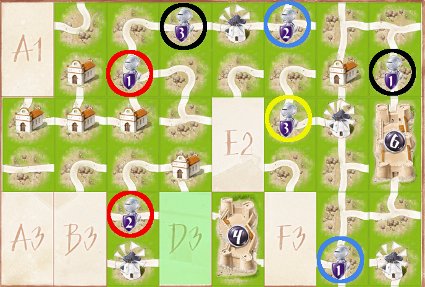
- The yellow-edged knight does not meet requirement a), it does not lie on an edge field.
- The black-edged knights do not meet requirement b). Although they lie on the edge and have a path connection to the outside, they do not have a direct connection. The left knight must have two cards to the edge connection, the right over his own, other card half.
- The red-edged knights do not meet requirement c). They lie on an edge field, but the knight lies on the inwardly facing card half.
- The blue-edged knights fulfill all conditions and contribute "3" together with their shield strength to the national defense.
Example for the second evaluation:
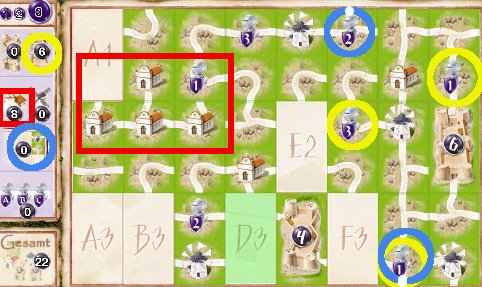
- The yellow circles mark the knights connected to Castle 6. No knight is connected to Castle 4, therefore 0 points for this castle. Castle 6 is connected to three knights. Since there is the second score, at least two knights would have been necessary, so there are six points for this.
- Four connected churches are marked in the red rectangle. Since this is evaluated with two points per church, there are eight points for this.
- A knight strength of eight would have been necessary for the national defense. Only two knights (blue circles) fulfill the condition for the national defense, but their strength only sums three, therefore also 0 points.
Largest knight group
The largest group of knights only comes after Last round to value. The Strength the largest, connected knight group sums and adds to the total score.
Final value
Example for a final evaluation. The result of the third score is displayed in the left of the score display, i.e. the mouse (invisible on the picture) was held via the red three of the round display.
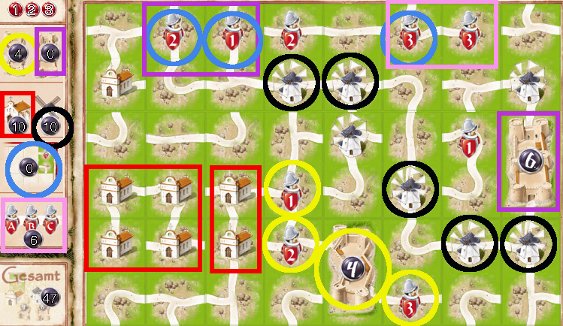
- Castle 4 has three tied knights (yellow circles) -> 4 points
- Castle 6 has only two knights (purple rectangles) –> 0 points
- There are four connected churches and once two connected churches (red rectangles) -> 2 x 4 + 2 = 10 points
- There are five connected windmills (black circles) -> 5 x 2 = 10 points
- After the third round, twelve points would have been necessary for the national defence. However, here only three knights with the summed strength of 6 contribute (blue circles) -> 0 points
- The largest contiguous knight group has a strength of 6 (rosa rectangle) -> 6 points
These 30 points together with the 17 points of the previous two scores give the total score of 47.
Playing
The game ends after the last score after the third round. The winner is the player with the highest overall score. As a solitary game, reaching as high a score as possible is the goal.

